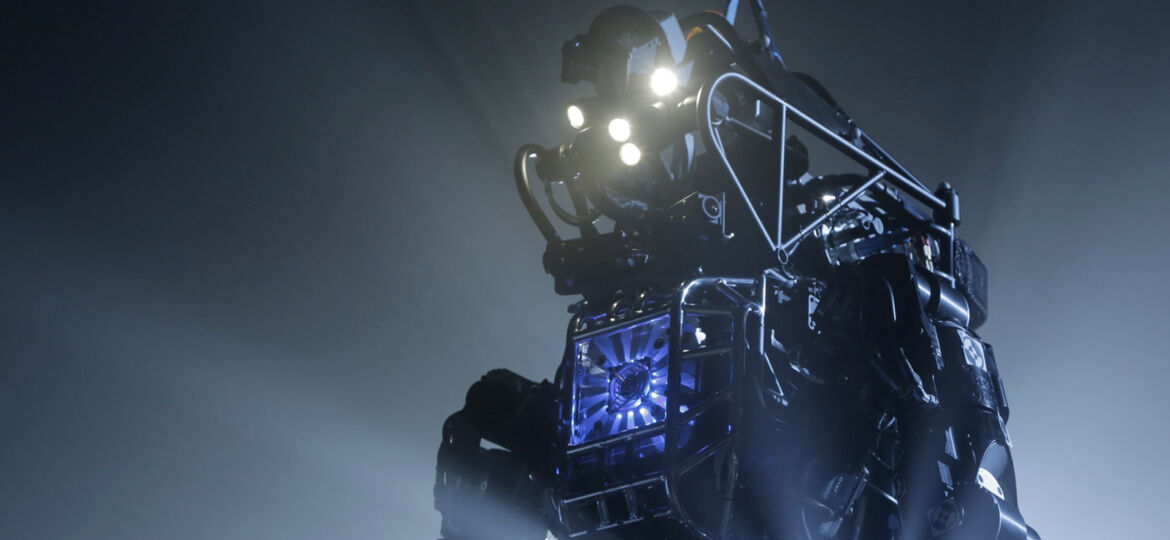
WHY THIS MATTERS IN BRIEF
Robotisists just crammed hundreds of millions of years of natural evolution into just two years.
Boston Dynamics has unveiled a hugely upgraded version of its ATLAS humanoid that is smaller, lighter, and more agile. Furthermore it’s been amazing to see the advancements the team has made in just two years – putting it into perspective the same types of advances in nature – the evolution of semi-autonomous bipedal mobility, took tens, if not hundreds of millions of years.
Last year Boston Dynamics showed off a battery powered version of the robot and now the “next generation” model, while still wireless, is smaller at just 5 feet 9 inches and 180 pounds compared to a predecessor that was six feet tall and weighed 330 pounds just a couple of years ago.
In the video the new robot is seen walking untethered in snow covered woods, opening doors, lifting and placing boxes on shelves and even face planting then immediately getting up unscathed after being pushed by an evil colleague. As quirky as these stunts might appear, and it’d be all to easy to pass them off as a marketing stunt they represent a number of significant technological leaps and demonstrate three vital things – the ability of the robot to adapt to a changing situation, its advanced ability to regain its feet after falling down, and last but maybe not least, the fact that the team really need to seriously rethink robot-human relations.
The new ATLAS is a huge technological leap forward compared to its predecessor, which was already a pretty incredible robot and it can do things we’ve never seen other robots doing before which not just makes it one of the most advanced humanoids in existence but also one of the most desired – particularly by the US military who Boston Dynamics have had close relations with ever since their first generation ATLAS robot won the hotly contested DARPA Robotics Challenge (DRC) in 2011 and scooped up a cool $12 million in follow on funding.
So, how did Boston Dynamics do it?
“The engineering team did a huge amount of work to make ATLAS lighter and more compact,” said Marc Raibert, founder and president of Boston Dynamics.
“One of the many things we did was use 3D printing to create the legs, so the actuators and hydraulic lines are embedded in the structure, rather than made out of separate components. We also developed custom servo-valves that are significantly smaller and lighter, and that work better than the aerospace versions we had been using.” He then added that there were lots of “other work by a great team that I won’t go into,” but we can easily guess that AI, particularly machine learning and machine vision, as well as many more of today’s emerging technologies such as LIDAR and new meta materials probably played their part as well.
Late last year, Raibert mentioned in a conference talk that this kind of integrated, additive manufacturing is something that Boston Dynamics was focusing on for the legs of its next generation robots. This makes sense because the lighter ATLAS is then the easier it’s going to be for the team to create the next generation of mobility and control systems that will be responsible for it taking another step towards full autonomy, and another step closer to replacing humans in the field – wherever that field, warehouse or war zone is.
Since founding the MIT Leg Lab and pioneering the concept of dynamic locomotion, Raibert, who spun off Boston Dynamics from MIT in 1992, has focused on robots that move in a nimble manner, much like humans and animals. One of his most famous creations is the BigDog quadruped, whose movements were so animal like that many people found the robot “creepy.”
The next gen ATLAS appears to achieve that same level of animal like agility, with the robot slipping and stumbling on snow but rapidly recovering its balance to continue marching. Raibert said that’s all thanks to his controls team, which has been developing new algorithms and refining the old ones. “They also are taking advantage of the improved strength-to-weight ratio that this robot has,” he added, “as well as other performance improvements.”
One question that some roboticists had about the demonstrations shown in the video is whether ATLAS was being controlled by a human operator or performing its actions fully autonomously. Raibert said that for the outdoor scenes, a human provides general steering via radio while the robot uses its stereo and LIDAR sensors to adjust to terrain variations. ATLAS also does its own balance and motion control. As for the indoor scenes with the cardboard boxes, he said the robot “chases the box around and stacks the boxes autonomously, once someone gets it set up and tells it to go.”
But of course, the big question in everyone’s minds is, why did Boston Dynamics develop this robot? Raibert wouldn’t give specifics but indicated that as far as Boston Dynamics is concerned, its vision remains the same as when he started it 24 years ago.
“Our long-term goal is to make robots that have mobility, dexterity, perception and intelligence comparable to humans and animals, or perhaps exceeding them, this robot is a step along the way.”
Watch this space…
















[…] at such a fast pace that we cram millions of years of evolution into just years – just like we did recently with the ATLAS robot, as well as a whole bunch of AI’s … But what about […]